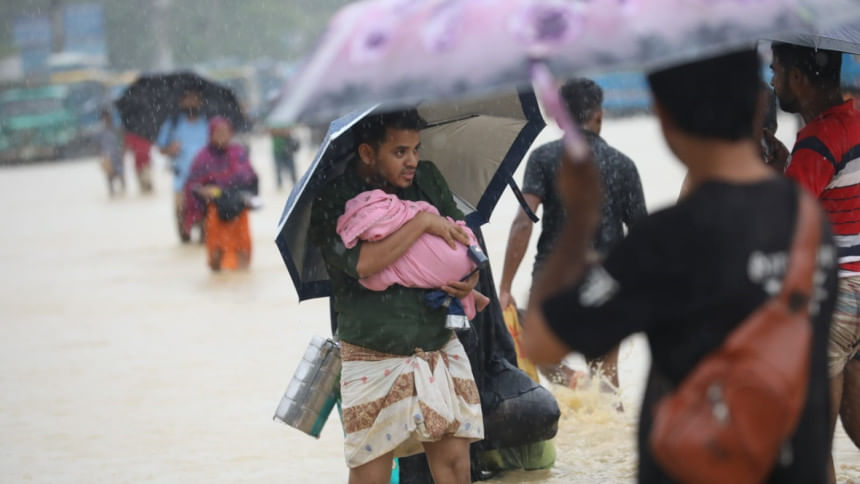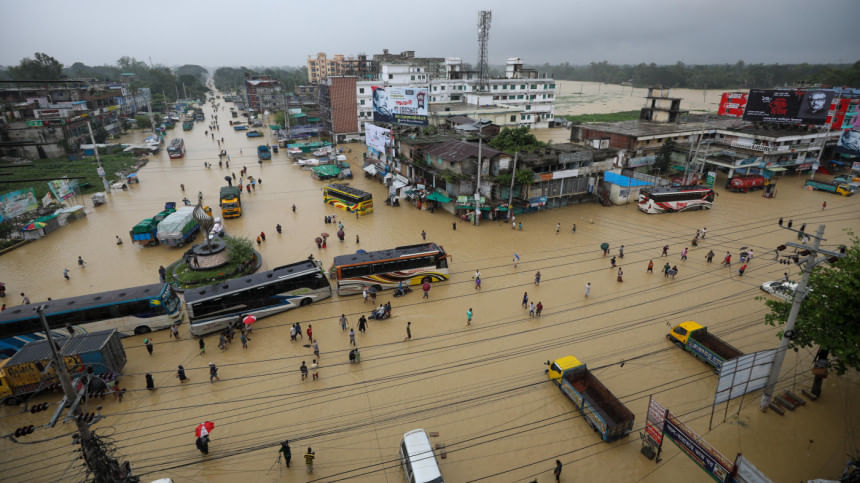
Last update on: Sat Aug 12, 2023 12:23 AM

Floods are not new in Chattogram. The coastal city’s low areas are just 2.5-3 metres above sea level, whereas the usual height of high tide is around five metres there. But in recent years, floods have become more bothersome than before, disrupting public life. In the past, we had a lot of ponds and other water bodies in the city. During high tides and heavy rain, water used to get drained into those water bodies, and during low tide it would be drawn back to the sea through canals and rivers. But as the population grew and the city got urbanised in an unplanned way, canals and rivers were encroached and the city coverage expanded. Now excess water from rain and tide cannot be absorbed by the soil and water bodies, nor can it flow down the natural drainage system. On top of that, with the increased population, the city creates more waste, which is dumped in the canals. The hills have been encroached upon as well, so they are more vulnerable to erosion. Then there are the effects of climate change, so we now have higher tides and more intense rainfall.
Back in 1995, a detailed regional master plan had been formulated for the city, which had predicted such a situation occurring in the near future. It pointed out what should be done, and exactly where canals were encroached at that time. But, unfortunately, no one took the initiative to implement the 1995 plan. However, a few years ago, our prime minister showed concern for the situation in Chattogram, and consequently, the Chattogram Development Authority (CDA) formed a master plan, which was approved by Ecnec. But the CDA lacked the capacity to implement the new master plan at the time. There was criticism regarding the viability of the plan’s many aspects as well. Following that, the prime minister acknowledged that there were problems, and formed a high authority committee chaired by the LGRD minister. We don’t know how effective that committee was, but after a while, the project was handed over to the army. But the army, too, was not completely prepared for a drainage project of this scale at that time. Meanwhile, we kept pointing out that there were inconsistencies and a lack of cooperation. Some of them were addressed, and the rest were left out.

As per historical accounts, there were 104 canals in the city, but in this master plan, only 57 canals were pointed out and the CDA started working on 36 of them. They claimed that they did not get enough funding from the finance ministry, so the contractors did not complete their work. The authorities say that almost 60-70 percent work of the project has been done. But the result we get is zero.
First of all, tidal regulators were supposed to be constructed to control tidal waves. But they are not functional at all. Some of the regulators now have structures, but there are no gates, which is worse than those that have no structures at all – because the half-made regulators create obstructions.
Effective results are possible even before the next monsoon season. But if we fail to do that, all the taxpayers’ money and their trust in authority will be washed away with the floodwater.
Then the CDA claims that they have dredged the canals, but where is the soil then? And while building retaining walls on the canal banks, they dumped a large quantity of excess soil back into the canal and used some soil to construct roads. This created more obstruction to the water flow. And where water gets obstructed, sediment and waste get accumulated, and eventually the canals can accommodate less and less water.
Moreover, silt traps were supposed to be built on the foots of the hills in the city. According to the plan, sediment coming down the hills would have been deposited there, and the contractors would collect that sediment and use them elsewhere. There are no silt traps installed yet.

We couldn’t build tide regulators, or ensure water drainage through canals, and we’re letting sediment come down the hills and get mixed up with our waste and obstruct the drainage channels. They are saying that almost 70 percent of the work is done. My question is: which part of the drainage system is actually functional?
It’s true that what happened this year – the unusually high tide and heavy rainfall – would still cause the floods even if the current projects were complete. But we could have mitigated the devastating impact.
The waterlogging problem in Chattogram city is not unsolvable. There are many coastal areas in the world, which are lower than the mean sea level. But their governments used hydrology engineering to turn that water problem into an asset. Some even used this to develop tourism.
So, I plead, on behalf of the residents of the port city who are suffering immensely, to the government to take responsibility for its citizens. Form an umbrella organisation for the coordination of the master plan; find out the issues in planning, design and implementation to make the drainage system actually functional. And please don’t just be active till the inauguration of the project; the city corporation must develop a manual for the logistics, and human resources for its operation and maintenance. And the city corporation must have access to the necessary resources and funding for maintenance. There should be clear guidance and regulations to prevent waste dumping into the canals. All 104 canals must be reclaimed. There should be high lift pumps ready so that in case of heavy rainfall, the water can be mechanically removed. There should be regular drainage rehearsals, just like firefighting drills. And before every monsoon, there should be routine checks if every aspect of the system is prepared.
If all these are done, and done immediately, I believe we can have a sustainable drainage solution for Chattogram. Effective results are possible even before the next monsoon season. But if we fail to do that, all the taxpayers’ money and their trust in authority will be washed away with the floodwater.
Md Delwar Hossain Mazumdar is executive member of the Forum for Planned Chittagong, and former chairman of the Institution of Engineers, Bangladesh (IEB).









